The Côte d’Azur Virtual Challenge will take you through a fabulous 100 mile (161 km) journey along the French Riviera, on the Mediterranean coast. Lots of pretty pictures on the app for me, but fewer taken on the roads around here.
Lessons Learned
As the summer wears on, I am learning some things about how I relate to exercise.
Timing matters:
- Morning walks before the whole world gets up and going are better than any other time. It’s quiet, cooler, and I don’t have to worry about being seen;
- Lunch or cancelled meeting walks are good for working out some amount of frustration, but make it hard to stay sharp in meetings afterwards;
- Walks after work should be really short top-up walks for the most part. If I need to achieve the bulk of my distance after a day of work, I’m in danger of not making it all. My energy is on the decline every hour after 1:00 PM;
- Walking after dinner is great for digestion and chats with Michael. Its sometimes fun to walk around sunset, but I rarely think to do so; and
- I have an unreasonable unwillingness to walk after dark. I’m not sure exactly what I’m afraid of. Seriously, I once woke up under a mosquito net to roll over and look at a hyaena, then a lioness. I fell back asleep after that with no problem. Pretty much everything else should be easier, right? But nope, I do not walk after dark. Considering that it is usually the least hot, least humid part of the day, I’m clearly missing out on some opportunities. Maybe I will try it once in the next few weeks.
Heat and humidity matter:
- Hot is uncomfortable, but bearable;
- Any humidity is like torture, at all temperatures. I can walk in humid air, but I am not going to enjoy it and anything I am wearing is in the laundry right after, and I’m in a shower to dry off. I am perfectly aware that sentence is illogical, but you’re just going to have to accept it is my truth;
- Absolute joy exists between 5°C and 15°C. I am a temperate being; and
- A very light breeze is nice, anything stronger is annoying as my eyes tear in the wind.
What I’m wearing matters:
- I’ve been wearing Saucony running shoes for something like 15 years now. On occasion I pick up secondary running shoes to try out others, but I never stick with them. I’m not generally brand loyal in my purchases, but this company has never disappointed me;
- Even the best shoes have limits, I can wear the soles flat and/or squish the cushioned sole into nothing at all in about eight months (possibly less moving forward, since my step count continues to climb per week);
- My Teva sandals are lovely, and have served me well around the world, but are not the best choice for walks over 45 minutes, regardless of the temperature; and
- I have finally bought enough workout gear that I now own some stuff with pockets. Why is this relevant? I need to carry a phone, a key, some Kleenex, and a mask. Yes, it is possible to carry them in my hands, but this because increasingly tedious on longer walks.
Rewards matter:
- My FitBit screen doing the fireworks thing when I hit a goal does very little for me. To be honest, I’m more compelled by the fear of entering too few steps into the Conqueror app than the thrill of reaching the step count goal;
- Being able to pick up a tea from Tim Horton’s in the last 5 minutes of my walk is something to look forward to. I can trick myself into a walk, simply be going the “wrong way” to get to Timmy’s, so I need to circle the block to get there. I remain motivated by food. No surprises there;
- The five trees planted per challenge completed is nice, but I really want to to find a way to plant a great big swathe, a few kilometres squared. We’re still looking for the right people to partner with through the Pale Blue Dot Foundation; and
- I am still getting a kick out of each and every medal that arrives. I haven’t worked out a solution to display them yet. I need to get on with it and set some anchors in walls… I’ve been avoiding handing some of the pictures since I moved into the condo for fear of punching holes in the walls. I need a cat burgling picture hanger to sneak in here and get everything up where it should be.
Postcards
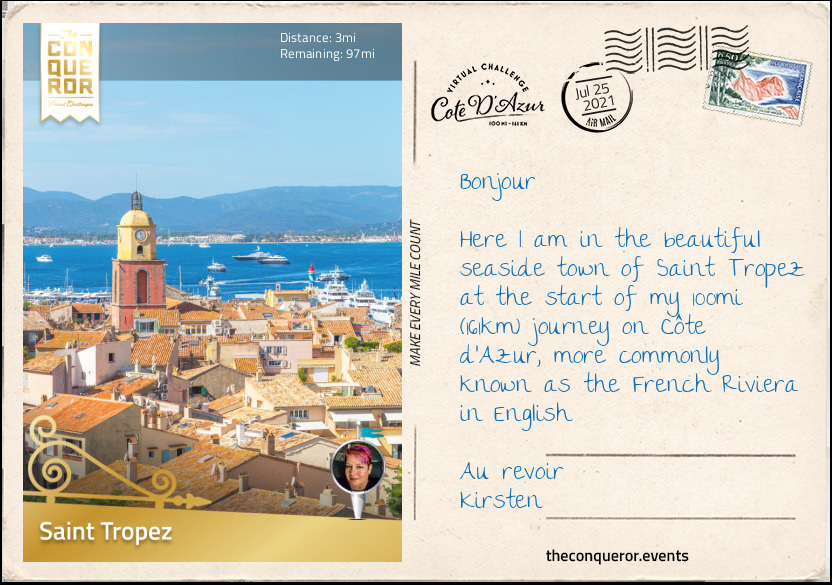
After an hour of travelling from Toulon-Hyères airport, I arrived in the once sleepy fishing village of Saint Tropez. Located on a headland with narrow cobblestone streets, Saint Tropez came to prominence in the second half of the 20th century with an influx of artists and later wealthy socialites. Today it continues to draw wealthy visitors and tourists.
Saint Tropez was named after Saint Torpes of Pisa, the patron saint of sailors. Torpes was once a gladiator or knight, it’s not clear which one but he was in the service of Emperor Nero. He turned to Christianity and when he refused to denounce it, the Emperor had him decapitated. His head was tossed in the Arno river and his body along with a rooster and dog were placed in a boat and sent out to sea. According to legend the boat landed in Saint Tropez near the current sailors’ cemetery. Found by a holy woman, the town was named in his honour. The rooster and dog fled and both had towns named after them – Cogolin and Grimaud.
The town is often considered as one of three starting points of Côte d’Azur – the literal translation is Azure Coast. In English we refer to it as the French Riviera. The Riviera runs the length of the southeast corner of France through the well-known towns of Cannes and Nice, the city-state Monaco and ending in Menton right at the border of France and Italy.
The term Côte d’Azur was coined in 1887 by poet and writer, Stéphen Liégeard when he wrote of his experience on the French Riviera describing the beautiful area and the deep azure colour of the sea. The book titled La Côte d’Azur was printed in 1888. Said to have been one of his greatest writings, Liégeard was awarded a Bordin Prize issued by the French Academy of Sciences.
At the foothill of Saint Tropez’s harbour pier is Tour Portalot, a 15th century tower that was built along with three others to fortify the town and protect its coast and port. Taking the stairs to the top of the tower, I am enchanted by the expansive views of the sea, as far as the eyes can see. The tower overlooks the Gulf of Saint Tropez, busy with ferries and pleasure boats cruising in and out of the harbour.
To the west of the tower up on a hill is the 17th century citadel. Built in a hexagonal shape with three turrets and several cannons, the citadel can only be accessed via a drawbridge. With its prime position on a hill, the citadel together with the towers built in the port, protected the town and the coastline for nearly two centuries. When the citadel couldn’t withstand the strength of modern artillery shells its protective and strategic role diminished and fell into disuse. Following extensive renovations the citadel was opened as a maritime museum. Its rooftop terrace provides sweeping aerial views of the town and Mediterranean Sea.
Before I departed Saint Tropez, I took a short stroll to La Tarte Tropezienne Restaurant to check out its famous pastry of the same name. When Alexandre Micka, a young Polish baker, created a dessert using his grandmother’s recipe in the 1950s, he could not have imagined how iconic the dessert would become in Southern France. The dessert rose to fame when Brigitte Bardot, in town to film a movie, was introduced to the delectable pastry and is said to have fallen in love with it. Brigitte suggested that the dessert be named after the town and as Brigitte grew in popularity so did the dessert. The pastry name was eventually trademarked and many stores were opened across Southern France.
An uncomplicated dessert the original version was made up of traditional French brioche that was split in half, filled with a vanilla and lemon cream, and topped with hard sugar crystals. Today the dessert is available in different shapes and sizes and occasionally with strawberries. More than 65 years later the cream filling remains a closely guarded secret and continues to be made with traditional methods.
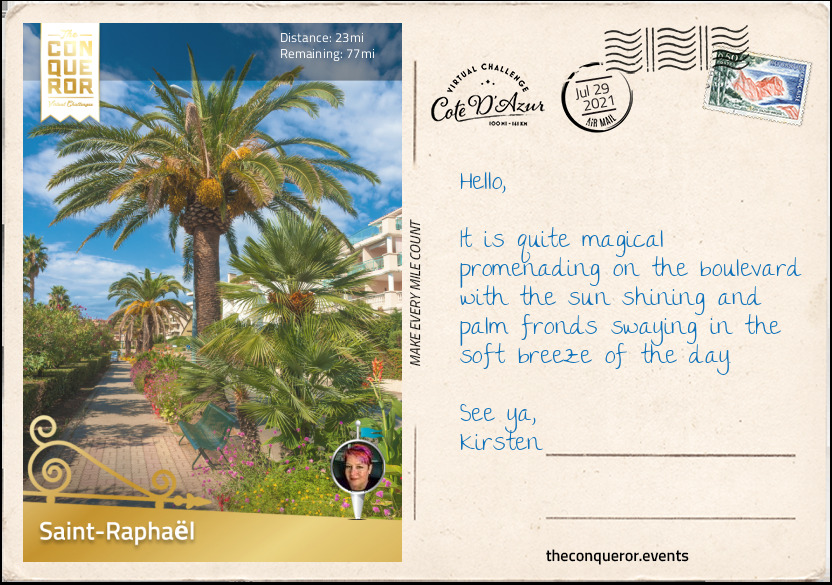
At the base of Esterel Massif is the seaside town of Saint-Raphaël. With 22mi (36km) of coastline and numerous beaches and coves, this is one place to put up an umbrella, lay down a towel and while away the day soaking up the sun or swim in the azure sea.
First of all though, I had to explore the old “Quartier du Village”, the old town where each day it hosts a flower and vegetable market. Offering Provencal food which is a region in south-eastern France, my tasting senses delighted in dipping croutons in a tapenade of black olives mixed with capers, anchovies, garlic and olive oil. Quenching my thirst with a refreshing Lime Perrier sparkling water I continued exploring.
Not far from the market I came across the Romanesque church of San Raféu. Originally built in the 12th century, a tower was added a century later to represent power rather than any defensive purpose. The 129 steps up the tower presented me with a breath-taking panoramic view of the town, the sea and the Massif. The presbytery has been converted into a museum showcasing artifacts from underwater excavations along with items from the Palaeolithic era to the Iron Age (3.3mya – 332BC).
I made my way down to the marina tucked away between the beaches in the Bay of Saint-Raphaёl and promenaded around it to Le Jardin Bonaparte, a public park with views of the old port and the sea. At the tip of the park stands a 15ft (5m) bronze statue of Archangel Raphaёl, whom the town was named after, holding hands with little Tobias. Just like the statue, Raphaёl and Tobias appear in the town’s coat of arms. The story told is that “Tobias was told by his father to collect money deposited with a relative, a merchant in a distant town; before he went he was to find a trustworthy companion. That companion was the Angel Raphael and together with Tobias’ dog they set out”. As such Raphaёl is seen as a symbol of companionship and protection.
With the sun setting and a full day of sightseeing, I located a sunbed with an umbrella near a restaurant and stretched out with an aperitif. Since it’s revered in the South of France I chose a Pastis, an aniseed and liquorice flavoured spirit. This transparent dark yellow spirit turns a cloudy pale yellow colour once mixed with water which is the preferred way to drink it. Makes for an interesting looking drink which as they say “must be tried at least once”.
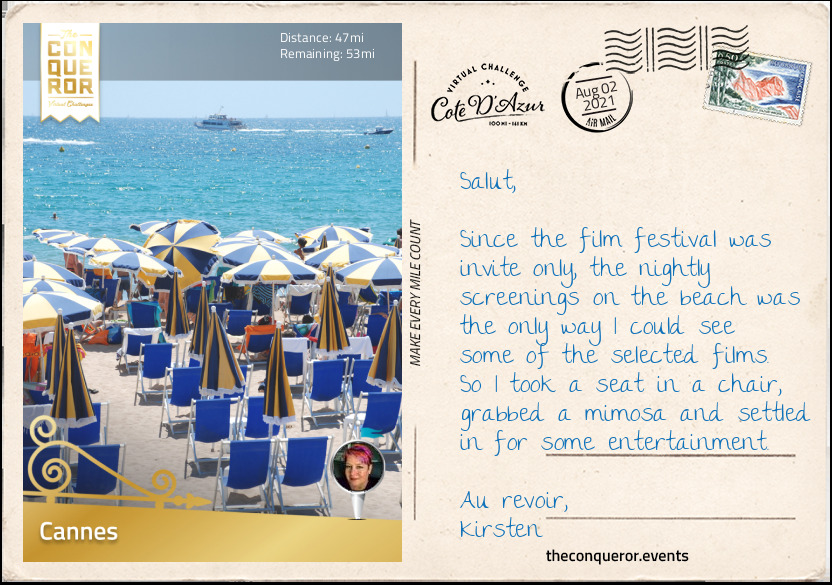
Tucked away between the Cannes Port to one side and turquoise Croisette Beach on the other is the Palais des Festival de Cannes where the annual Cannes Film Festival is held. The internationally renowned Film Festival has been running for over 70 years. As part of the Big Five film festivals which include Venice, Berlin, Toronto and Sundance in the US, the Cannes Film Festival is where all new films and documentaries from around the world are previewed.
The festival is a prestigious event that is by invitation only. It is attended annually by nearly 40,000 guests including celebrities, rising stars, hopefuls of the Palme D’Or Award and a staggering 4,500 journalists show up to capture every facet of the event.
As famous as the event is today, the festival had very interesting beginnings. Back in the 1930s the only festival that existed worldwide was the Venice Film Festival which started in 1932. Presenting movies for the coveted Mussolini Cup, the French became disillusioned when the judges’ decisions were overruled by Mussolini and Hitler and instead of a French film winning, the winners were an Italian film and German documentary.
Unhappy with the situation the French, British and Americans withdrew from the festival and inspired the French to establish their own film festival. As such Le Festival International du Film was born with Cannes as the chosen location, largely due to its Côte d’Azur location. The first event was slated for September 1939 with Hollywood celebrities brought in by an ocean liner chartered by the film studio Metro-Goldwyn-Mayer. Unfortunately, World War II started in September and although the festival was delayed 10 days eventually it was cancelled. The festival was relaunched in 1946 and with the exception of two years when it didn’t take place, the festival has been a major presence in the film industry remaining the most exclusive event of all film festivals.
Of course Cannes was not just about the film festival. It’s major street, Boulevard de la Croisette, is one of the most iconic streets in France. It runs for a mile (1.6km) alongside the coastline with luxurious hotels, casinos and designer stores dotting the street.
As lovely as that may be what I was more interested in was the Marché Forville, a large undercover food market where I could indulge in locally grown fresh produce, a Spanish paella or Italian ravioli with Provençale pasta sauce.
From here I took a stroll through Le Suquet, an old neighbourhood that was once the original fishermans’ residential area. With pastel-coloured buildings lining the steep cobbled street, the area was filled with restaurants. As I made my way up, I came across Notre-Dame d’Espérance, a 14th century stone church with a belltower, and adjacent to it is a medieval castle that houses a unique collection of medieval artefacts, paintings and Asian instruments. The collection was bequeathed by a local resident and the castle is now used as a museum. A further 109 steps took me to the top of the tower for a spectacular view of Cannes.
In the distance I could see Sainte-Marguerite Island, which is famously known for holding the mysterious Man in the Iron Mask as prisoner for a period of 11 years. He wore a mask because King Louis XIV never wanted him to be identified. Plenty of speculations have been made since his death in 1703 but no conclusive evidence has ever been found. One thing for certain was that his mask was made of cloth not iron and Alexander Dumas was inspired to write his novel, The Man in the Iron Mask. The island is a museum today which includes the masked man’s cell.
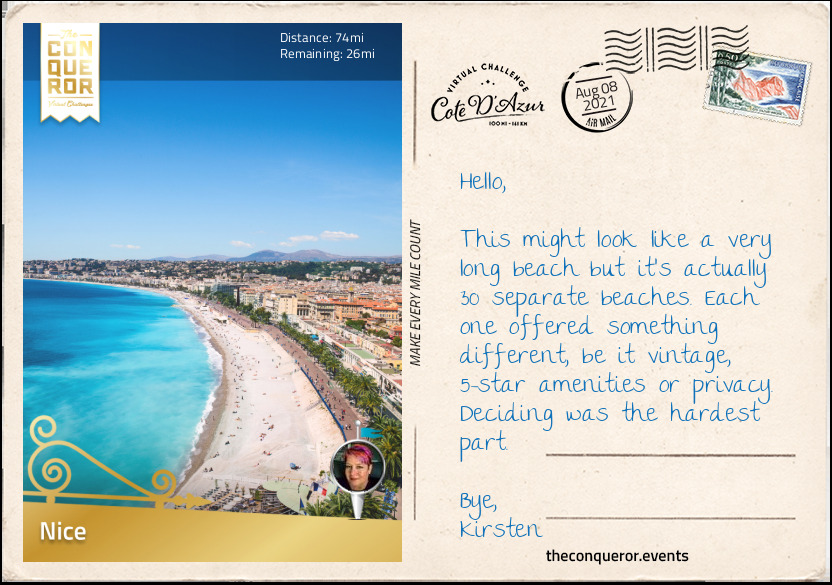
Nice is the seventh most populous city in France, second-largest city on the Mediterranean coast and second-largest city in the region. With an airport a mere 4mi (7km) from the city centre, Nice is the gateway to the French Riviera.
It has a plethora of museums, festivals, a hilltop park with uninterrupted views of the sea, several squares surrounded by buildings in red ochre, a 4mi (7km) beach alongside the main promenade and the old port. So many options, where to begin?
Starting with the festivals, Nice is host to an annual jazz festival and the Carnaval. The first Jazz Festival opened in 1948 with the likes of Louis Armstrong, Velma Middleton and Earl Hines in attendance. The Nice Carnaval is one of the major international carnival events alongside the ones in Rio de Janeiro, Brazil and Venice, Italy. The very first Carnaval took place in 1873 – although records indicate one as early as 1294 – with a parade of masquerades, floats and competitions. The event has a special theme chosen each year where artists create floats and figures made out of papier-mâché. They parade down the street interspersed with street performers and musicians. One of the highlights that is unique to Nice’s carnival is the costumed actresses atop floral floats showering the audiences with flowers. This Flower Battle as it’s called was started in 1876 as a way to exchange flowers and entertain tourists but today it represents and honours the work of local producers.
Nice has long drawn artists to its shores with the likes of Henri Matisse, Marc Chagall and sculptor Sacha Sosno. Both Matisse and Chagall have museums dedicated to their works. Matisse was known as the “King of Colour”. Bedridden due to illness he was forever on a quest to induce more and more colour into his paintings making them as bright as possible. Loving birds and flowers, they are found throughout his works. When he could no longer paint, he took to cut-out collages arranging them into varying compositions creating murals and large scale works. His greatest achievement was the stained glass windows on the Rosaire Chapel which he gifted to his friend Monique, who was his nurse for a period of time later becoming a nun.
In the heart of Nice located amongst century-old buildings is the highly modern Contemporary Art Museum and within its perfectly manicured garden sits Sosno’s unique square head sculpture. The cube-shaped sculpture with a chin is titled “Thinking Inside the Box” and at 85ft (26m) tall it houses a library over three floors. Sosno believed his art needed to leave a lot to the viewer’s imagination by creating works that were either having a void, imagine a torso sculpture with a rectangular section missing from the centre of it, or the opposite filled with “obstructive addition” such as the square head. In his words: “I only do 50% of the work; other people have to finish creating the sculpture”.
To the east of the city up on a hill is the historic Castle Hill park. Once home to a citadel that was demolished in the 18th century, it now boasts panoramic views of Angels Bay, the old port and the city skyline. Taking a stroll through the forested canopy I reached the 18th century historic cemetery adjacent to the Jewish cemetery and Holocaust memorial built atop the fortress’ remains. Notable figures such as Alfred Van Cleef jewellery and luxury watches designer; Emil Jellinek creator of Mercedes trademark; and Gaston Leroux the author of the famous Phantom of the Opera are buried here. Just below the top viewing platform is a manmade waterfall and pond. Reaching the top I am afforded the quintessential view of the beach, the azure sea, the promenade and the dense city alongside it.
Descending from the park and rounding it at the base, I came across a massive monument built into the rocky hillside commemorating the 4,000 locals killed in WWI. Built in the mid-1920s the memorial is 105ft (32m) tall. The large urn in the centre holds the names of the 3,665 Niçois soldiers who died in the war.
Now to stroll into the old port, find an outdoor seat at a café with a view of the ocean and time to settle in with the tuna based Salade Niçoise because it was invented here paired with a glass of Provencal Rosé with its pretty salmon colour and crisp and refreshing taste. Bon appétit.

Grace Kelly, Formula 1 Grand Prix, glitz and glamour, playground for the rich and famous are just some of the things that come to mind when I think of Monaco.
This tiny city-state of 0.81mi² (2.1km²) is one of the densest countries in the world. If you tried to fit Monaco in New York City’s Central Park it would take up only 60% of the space. Its border length is a mere 3.4mi (5.5km), with the world’s shortest coastline of 2.4mi (3.8km) and a width that varies from 5,577-1,145ft (1,700-349m). It is the second smallest country in the world after Vatican City.
Monaco has a population of 38,600 of which approximately 12,300 of them are classified as millionaires. A tax haven with luxurious buildings and relaxed lifestyle, Monaco has drawn the likes of Roger Moore (actor known for his James Bond roles during the 1970s), Bono (lead singer of U2) and Björn Borg (famous tennis player) to take up residency in Monaco. The most famous, however, is Grace Kelly, an American actress from the mid-20th century who married Rainier III, Prince of Monaco.
Member of the House of Grimaldi, Prince Rainier reigned Monaco for nearly 56 years. When he ascended the throne in 1949, as much as 95% of Monaco’s economy was derived from gambling houses with the first casino, Casino de Monte-Carlo, opening its doors in 1858. The casino was a huge success and within a decade it was making so much money that the city-state decided to stop collecting tax from its citizens and has remained that way ever since. During his reign, Rainier undertook extensive reforms and expanded Monaco’s economy beyond gambling to such an extent that today the city’s annual revenue from gambling is only three percent.
One of the most prestigious sporting events held in Monaco is the Formula 1 Grand Prix. With a narrow circuit, tight corners and a tunnel, it was once compared to cycling around a living room. The circuit has many elevation changes, largely due to Monaco’s rocky and steep location, making it one of the most demanding tracks in Formula 1 racing.
In the centre of Monaco is the district of La Condamine where the annual Yacht Show is held in Port Hercules and visited by over 30,000 people. An estimated 125 superyachts are on display featuring boats from 65-300ft (20-90m) in length. Here yacht enthusiasts, designers, builders and brokers gather to trade, explore or upgrade.
Complementing the superyachts in the harbour is the state-of-the-art yacht clubhouse. Opened in 2014, the clubhouse is shaped like a docked cruise-liner. It has 5 decks (floors) and built with eco principles in mind. Located at the foot of the harbour, it is 669ft (204m) long providing spectacular views of the ocean on one end, the F1 track down the other and across the superyachts in the port.
Across the port on the other side of the clubhouse is Monaco-Ville (Old town). Located up high on a promontory, it is the oldest district in Monaco and the location of the Prince’s Palace. The palace was originally built in 1191 and was seized in 1297 by François Grimaldi and his cousin, Rainier I. François had no heirs, so the Grimaldi family that currently rule are actually descendants of Rainier. The Palace has been the Grimaldi home for 700 years and its evolution is a direct reflection of the family’s and the country’s history.
Near the tip of the promontory is the Oceanographic Museum. What is truly fascinating is the building itself. At 279ft (85m) high the building towers over the edge of the cliff face. With a Baroque Revival architecture it is almost at odds with the rugged cliff face beneath it yet they complement one another. From the sea it looks monumental. From land it seems as it could topple into the sea.
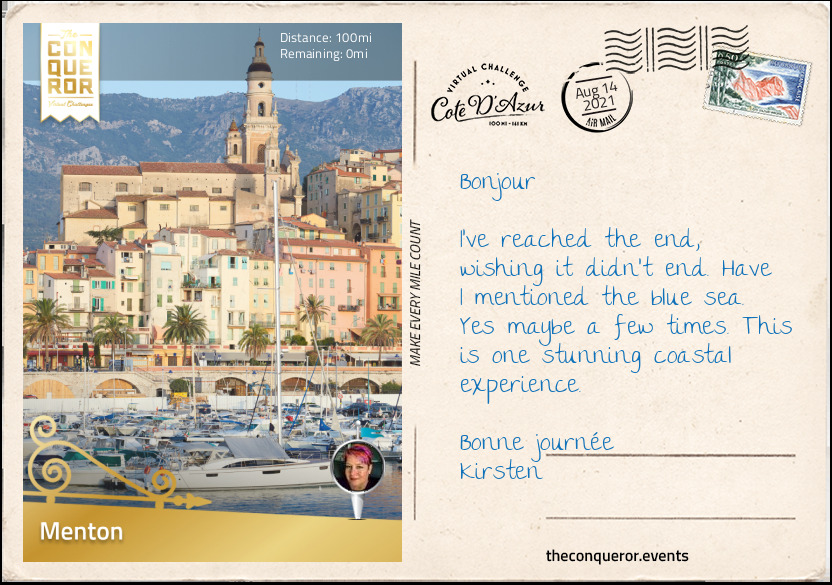
Nestled between Monaco and the Italian border is the garden city of Menton. Being tucked between the mountains and the sea, Menton is protected from winds and low temperatures giving it a lovely warm and dry climate. It’s hot summers rarely exceed 86°F (30°C) and the winters are mild. This unique climate is an ideal location for Mediterranean gardens. As a result Menton has six botanical gardens within it 5.5mi² (14km²) area.
Every two years Menton opens all its gardens to the public as part of the Garden Festival, where landscape design competitions and garden displays are part of the program. The city is so committed to its green spaces that it won the Quatre Fleurs certification – given to towns committed to horticulture – for several years in a row.
The climate is also an excellent environment for growing oranges and lemons and as such Menton is famous for its annual Lemon Festival and the Menton lemon. Menton was the largest lemon producer in Europe until the 1930s. Following a decline it took until recent times for that production to turn around. Today, there are 5,000 trees that produce more than 150 tonnes of lemons per year in Menton and its neighbouring communes.
In 1928 a hotelier organised a flower and citrus fruit exhibition in the gardens of his hotel. It was so successful the following years it spilled out into the streets and by 1935 it officially became an annual Lemon Festival. The festival is a huge event with a new theme each year. The centre of town, floats and statues are decorated in oranges and lemons. Interestingly though the citrus fruits used for the festival are actually from Spain because the Menton lemons are a protected fruit and there aren’t enough produced to use in the event. Menton is quite environmentally conscious and at the end of the festival all the fruit is sold at a special market at a very low price in order to reduce wastage.
The old town of Menton is up on a hill and largely pedestrianised with narrow winding streets and colourful facades.
Packed next to each other the buildings are narrow themselves, four to five storeys high, with French windows adorned with external shutters. Amongst the buildings is the Baroque style Basilica of Sant Michel. Construction began in 1619 at the request of Prince Monaco and took two centuries to fully complete. Its 173ft (53m) steeple protruding above the rooflines is visible from afar.
At the base of the hill is the old port and the nearby 17th century bastion which once served as a fort is now a museum exhibiting the works of Jean Cocteau, an artist, playwright, poet and filmmaker from early to mid-20th century. Across the street is the sister museum in a large and modern building also housing Jean Cocteau’s works.
Leaving the museum for a stroll along the shoreline and absorbing the last of the azure sea, I reached the end of my journey having completed 100mi (160km) from Saint Tropez to Menton.
On a balmy afternoon I took a seat at a quaint little café and indulged in a local favourite, the classic lemon tart, tingly on the tongue but with a sweet crispy base and a cappuccino. Here I waited for the sun to set and I reminisced about my Côte D’Azur travels.

